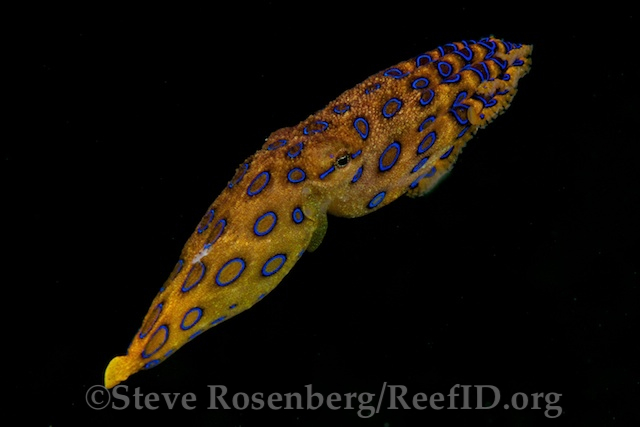By Steve Rosenberg, Executive Editor for ReefID.org
The blue-ringed octopus may be a beautiful creature, but it is recognized as one of the world’s most deadly animals. Usually only measuring 4 to 8 inches (approximately 10 to 20 centimeters) across, the blue-ringed octopus normally appears grey or beige with light brown patches when it is at rest, but when agitated its 50 or 60 bright blue rings appear and pulsate with color, as a warning. Inside the salivary glands of the blue-ringed octopus live colonies of bacteria that produce tetrodotoxin, a potent neurotoxin found in such marine life as pufferfish. Although they are diminutive is size and relatively docile, they can be dangerous to humans. They may bite attackers, including humans, if provoked, causing respiratory arrest. A bite from a blue-ringed octopus can completely paralyze and kill an adult human in a matter of minutes. There is no known antidote.

The blue-ringed octopus is commonly found in shallow, sandy areas surrounding the coastal reefs of Australia and the western Indio-Pacific. They are most active after dark, spending most of the daylight hours hidden away in their nests. They primarily feed on small crabs and mollusks, ambushing from behind and enveloping their prey with their in their arms. They use their beak to bite a hole through its victim’s shell, to inject toxic saliva. With its arms and beak, the creature tears soft pieces from the prey, sucking the rest of the meat from the shell once it becomes partially digested by the saliva.
Like all octopods, the blue-ringed octopus has no skeleton and is thus very flexible and maneuverable. It can squeeze into tiny crevices and make dens in bottles, aluminum cans, or mollusk shells. The blue-ringed octopus is also known to burrow into sand or gravel to conceal itself.
Did you know: The female lays her eggs in several unattached clumps, which she carries in her arms until they hatch. After the young emerge from their eggs, the mother dies.
Photographers Notes: For photographers you obviously have to be a bit careful when you are shooting Blue-ringed octopuses. Don’t touch them with your bare hands. They will move around as they search for food. Don’t startle them with quick movements. Wait until they move into an area that will give you a little room to move around to change your lens angle. Try to get as low as possible to give yourself a clean/solid background to shoot against. Take a test shot of something of the same degree of reflectance so that you can preset your controls for an appropriate exposure. The image here was taken with a Nikon D300, 60mm macro lens in a Subal housing while the octopus was swimming. The locations was Magic Pier in Buton, from the Pelagian dive yacht operating out of Wakatobi Dive Resort in southern Sulawesi, Indonesia.

